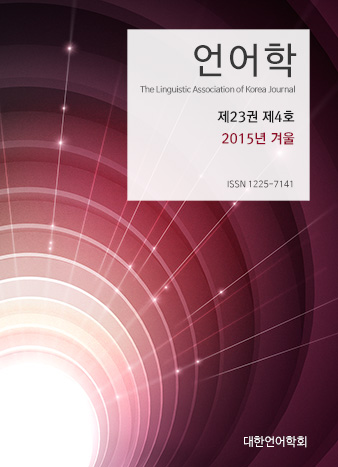대한언어학회 전자저널

23권 4호 (2015년 12월)
Abstract
Kim, Chonghyuck & Wong, Zechy. (2015). On the Distribution of Ownself in Singapore English. The Linguistic Association of Korea Journal 23(4), 45-62. Singapore English, a variety of English born out of intense contact with other local languages, has a unique self-expression in its lexicon - ownself. This self-expression displays partial convergence with its believed source, Chinese ziji: Like ziji, ownself can appear in a non-argument position, where it performs all of zijis emphatic functions. Unlike ziji, however, ownself cannot appear in an argument position. This partial convergence presents an apparent problem for substratist theories of creole genesis in contact linguistics (e.g. Lefebvre 1998; Bao 2005), because the theories predict full syntactic and semantic convergence between ownself and ziji. In this article, we resolve this problem by analysing the peculiar distribution of ownself as a consequence of grammatical competition between lexical items with overlapping distributions; ownself enters into competition with other self-expressions (e.g., himself) in argument position, and loses out in the process. In recent years, competition has been claimed to play a key role in the creation of new grammatical features in contact situations (Mufwene 2003, 2005; Aboh 2009), but the mechanics of such competition have largely remained elusive. Our analysis, to the extent that it is successful, can be construed as one specific way in which competition influences the creation of a new linguistic feature.
Keywords
# reflexives # ownself # ziji # Creole # Singapore English
References
- Aboh, E. (2009). Competition and selection: That’s all. In E. O. Aboh & N. Smith (Eds.), Complex processes in new languages (pp.317-344). Amsterdam: Benjamins.
- Ahn, B. (2010). Syntactic Configurations of Emphatic Reflexives. Ms. Retrieved September 12, 2015 from http://www.byronahn.com/papers/Ahn-PBChandout.pdf?ckattempt=1.
- Anderson, S. (1969). West Scandinavian Vowel Systems and the Ordering of Phonological Rules. Unpublished doctoral dissertation. MIT. Boston, MA.
- Bao, Z. (2005). The aspectual system of Singapore English and the systematic substratist explanation. Journal of Linguistics 41(2). 237-267.
- Bao, Z. (2009). One in Singapore English. Studies in Language 33(2). 338-365.
- Chomsky, N. (1981). Lectures on Government and Binding. Dordrecht: Foris.
- Kiparsky, P. (1973). ‘Elsewhere’ in Phonology. In S. Anderson and P. Kiparsky (Eds.), A Festschrift for Morris Halle (pp. 93-106). New York: Holt, Rinehart and Winston.
- Lefebvre, C., & John, L. (1994). Relexification in Creole Genesis. Unpublished manuscript.
- Lefebvre, C. (1998). Creole genesis and the acquisition of grammar: The case of Haitian creole. Cambridge: Cambridge University Press.
- Mufwene, S. (2003). Competition and selection in language evolution. Selection 3. 45-56.
- Mufwene, S. (2005). Language evolution: The population genetics way. In G. Hauska (Ed.), Gene, Sprachen, und ihre Evolution (pp. 30-52). Regensburg: Universitaetsverlag Regensburg.
- Musken, P. (1981). Half-Way between Quechua and Spanish: The Case for Relexification. In A. R. Highfield and A. Valdman, (Eds.), Historicity and variation in creole studies (pp. 52-79). Ann Arbor Ml: Karoma.
- Neeleman, A., & Szendröi, K. (2007). Radical Pro Drop and the Morphology of Pronouns. Linguistic Inquiry 38(4). 671-714.
- Reinhart, T., & Reuland, E. (1993). Reflexivity. Linguistic Inquiry, 24(4). 657-720.
- Wee, L. (2007). Singapore English x-self and ownself. World Englishes 26(3). 360-372.